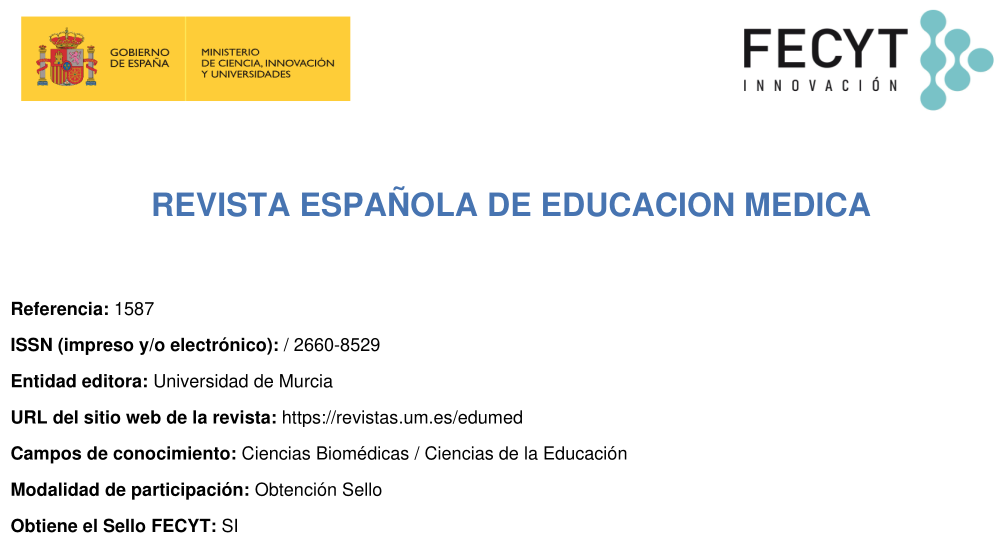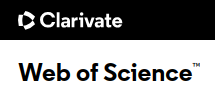Mejoría en la adquisición de conocimientos en Oftalmología mediante un curso E-Learning
Resumen
(1) Antecedentes: formación insuficiente en Oftalmología en Chile, susceptible a mejoríacon modalidad E-learning. El objetivo es describir el diseño e implementación de un curso deOftalmología con metodología E-Learning para estudiantes de medicina y médicos generales,evaluando la percepción de los estudiantes y los resultados de aprendizaje; (2) Métodos: Para eldiseño del curso se utilizó el modelo de Kern, identificando como problema principal lainsuficiente formación oftalmológica de médicos generales en Chile. Se evaluó la percepciónestudiantil en dos etapas: la primera, mediante una encuesta al final cada clase, y la segunda, alfinal del curso para un análisis global. El aprendizaje se evaluó a través de la comparación deresultados entre una prueba de selección múltiple previo al inicio del curso y una prueba al finalde éste; (3) Resultados: Se diseñó un curso de 33 video-clases agrupadas en 9 bloques temáticos. Serealizaron 2 versiones con 429 estudiantes en total. Un 61% refirió enfrentarse a patologíaoftalmológica al menos una vez por semana. Un 78% de los estudiantes refirió estar de acuerdo ocompletamente de acuerdo en que la modalidad a distancia era de su elección. En cuanto a laautopercepción, previo al curso un 22% consideraba que su formación en oftalmología eraadecuada, comparado con un 95% al finalizar el curso. Tanto las calificaciones obtenidas como elporcentaje de aprobados tuvieron una mejoría estadísticamente significativa al comparar losresultados entre la prueba diagnóstica y final (5,3: 68,9% vs 6,4: 97,52%, respectivamente. P<0,001);(4) Conclusiones: El curso de oftalmología en modalidad e-learning fue bien evaluado por losestudiantes y lograron adquirir conocimientos de la especialidad.
Descargas
Métricas
-
Resumen1302
-
pdf384
Citas
Arntz A, Khaliliyeh D, Cruzat A, Rao X, Rocha G, Grau A, Altschwager P, Azócar V. Open-care telemedicine in ophthalmology during the COVID-19 pandemic: a pilot study. Arch Soc Esp Oftalmol (Engl Ed). 2020 Dec;95(12):586-590. English, Spanish. doi: 10.1016/j.oftal.2020.09.005. Epub 2020 Oct 13. PMID: 33160746; PMCID: PMC7553099.
Management of Ophthalmic Disease in General Practice.” British Journal of General Practice, nov. 1993, pp. 459–462.
Hong H, Mújica OJ, Anaya J, Lansingh VC, López E, Silva JC. The Challenge of Universal Eye Health in Latin America: distributive inequality of ophthalmologists in 14 countries. BMJ Open. 2016 Nov 18;6(11): e012819. doi: 10.1136/bmjopen-2016-012819. Erratum in: BMJ Open. 2016 Dec 30;6(12):12819corr1. PMID: 27864248; PMCID: PMC5128993.
Teo, Michelle Ai Ling. “Improving Acute Eye Consultations in General Practice: A Practical Approach.” BMJ Quality Improvement Reports, vol. 3, no. 1, 2014, doi:10.1136/bmjquality. u206617.w2852.
Tso, M. O. M., Goldberg, M. F., Lee, A. G., Selvarajah, S., Parrish, R. K., & Zagorski, Z. (2007). An International Strategic Plan to Preserve and Restore Vision: Four Curricula of Ophthalmic Education. American Journal of Ophthalmology, 143(5), 859–865. doi: 10.1016/j.ajo.2007.01.055
A Novel 3-Year Longitudinal Pilot Study of Medical Students’ Acquisition and Retention of Screening Eye Examination Skills. (2006). Ophthalmology, 113(6), 984. doi: 10.1016/j.ophtha.2006.03.044
Statham MO, Sharma A, Pane AR. Misdiagnosis of acute eye diseases by primary health care providers: incidence and implications. Med J Aust 2008; 189(7): 402-4.
Sheldrick J, Vernon S, Wilson A. Study of diagnostic accord between general practitioners and an ophthalmologist. BMJ 1992; 304(6834): 1096.
Walsh K. E-learning in ophthalmology: ¿where next? Indian J Ophthalmol. 2014 Dec;62(12):1178. doi: 10.4103/0301-4738.149160. PMID: 25579371; PMCID: PMC4313511.
Vaona A, Banzi R, Kwag KH, Rigon G, Cereda D, Pecoraro V, Tramacere I, Moja L. E-learning for health professionals. Cochrane Database Syst Rev. 2018 Jan 21;1(1):CD011736. doi: 10.1002/14651858.CD011736.pub2. PMID: 29355907; PMCID: PMC6491176.
Jeong HC, So WY. Difficulties of Online Physical Education Classes in Middle and High School and an Efficient Operation Plan to Address Them. Int J Environ Res Public Health. 2020 Oct 5;17(19):7279. doi: 10.3390/ijerph17197279. PMID: 33028002; PMCID: PMC7579093.
Subsecretaría de Telecomunicaciones. IX Encuesta Accesos y Usos de Internet [Internet]. Gobierno de Chile (Santiago, Chile); 2017-. Disponible en: https://www.subtel.gob.cl/wp-content/uploads/2018/05/ppt_usos_may2018.pdf
Sweet LR, Palazzi DL. Application of Kern's Six-step approach to curriculum development by global health residents. Educ Health (Abingdon). 2015 May-Aug;28(2):138-41. doi: 10.4103/1357-6283.170124. PMID: 26609014
George PP, Papachristou N, Belisario JM, Wang W, Wark PA, Cotic Z, Rasmussen K, Sluiter R, Riboli-Sasco E, Tudor Car L, Musulanov EM, Molina JA, Heng BH, Zhang Y, Wheeler EL, Al Shorbaji N, Majeed A, Car J. Online eLearning for undergraduates in health professions: A systematic review of the impact on knowledge, skills, attitudes, and satisfaction. J Glob Health. 2014 jun;4(1):010406. doi: 10.7189/jogh.04.010406. PMID: 24976965; PMCID: PMC4073252.
Walsh K. E-learning for medical education: reflections of learners on patients. Ulster Med J. 2018 Jan;87(1):46-48. Epub 2018 Jan 31. PMID: 29588558; PMCID: PMC5849955.
Heydari MR, Taghva F, Amini M, Delavari S. Using Kirkpatrick's model to measure the effect of a new teaching and learning methods workshop for health care staff. BMC Res Notes. 2019 Jul 10;12(1):388. doi: 10.1186/s13104-019-4421-y. PMID: 31292006; PMCID: PMC6617554.
Sullivan GM, Artino AR Jr. Analyzing and interpreting data from likert-type scales. J Grad Med Educ. 2013 Dec;5(4):541-2. doi: 10.4300/JGME-5-4-18. PMID: 24454995; PMCID: PMC3886444.
Austin Z, Sutton J. Qualitative research: getting started. Can J Hosp Pharm. 2014 Nov;67(6):436-40. doi: 10.4212/cjhp. v67i6.1406. PMID: 25548401; PMCID: PMC4275140.
Kim TK. T test as a parametric statistic. Korean J Anesthesiol. 2015 Dec;68(6):540-6. doi: 10.4097/kjae.2015.68.6.540. Epub 2015 Nov 25. PMID: 26634076; PMCID: PMC4667138.
Bagheri N, Mehta S. Acute Vision Loss. Prim Care. 2015 Sep;42(3):347-61. doi: 10.1016/j.pop.2015.05.010. PMID: 26319342.
Frings A, Geerling G, Schargus M. Red Eye: A Guide for Non-specialists. Dtsch Arztebl Int. 2017 Apr 28;114(17):302-312. doi: 10.3238/arztebl.2017.0302. Erratum in: Dtsch Arztebl Int. 2017 Sep 22;114(38):641. Erratum in: Dtsch Arztebl Int. 2017 jul;114(24):418. PMID: 28530180; PMCID: PMC5443986.
Balmer A, Munier F. Differential diagnosis of leukocoria and strabismus, first presenting signs of retinoblastoma. Clin Ophthalmol. 2007 Dec;1(4):431-9. PMID: 19668520; PMCID: PMC2704541.
Silva JC, Bateman JB, Contreras F. Eye disease and care in Latin America and the Caribbean. Surv Ophthalmol. 2002 May-Jun;47(3):267-74. doi: 10.1016/s0039-6257(02)00286-2. PMID: 12052413.
Derechos de autor 2022 Servicio de Publicaciones de la Universidad de Murcia

Esta obra está bajo una licencia internacional Creative Commons Atribución-NoComercial-SinDerivadas 4.0.
Las obras que se publican en esta revista están sujetas a los siguientes términos:
1. El Servicio de Publicaciones de la Universidad de Murcia (la editorial) conserva los derechos patrimoniales (copyright) de las obras publicadas y favorece y permite la reutilización de las mismas bajo la licencia de uso indicada en el punto 2.
© Servicio de Publicaciones, Universidad de Murcia
2. Las obras se publican bajo una licencia Creative Commons Reconocimiento-NoComercial-SinObraDerivada 4.0.
![]()
3. Condiciones de auto-archivo. Se permite y se anima a los autores a difundir electrónicamente las versiones preprint (versión antes de ser evaluada y enviada a la revista) y/o post-print (versión evaluada y aceptada para su publicación) de sus obras antes de su publicación, ya que favorece su circulación y difusión más temprana y con ello un posible aumento en su citación y alcance entre la comunidad académica.



















